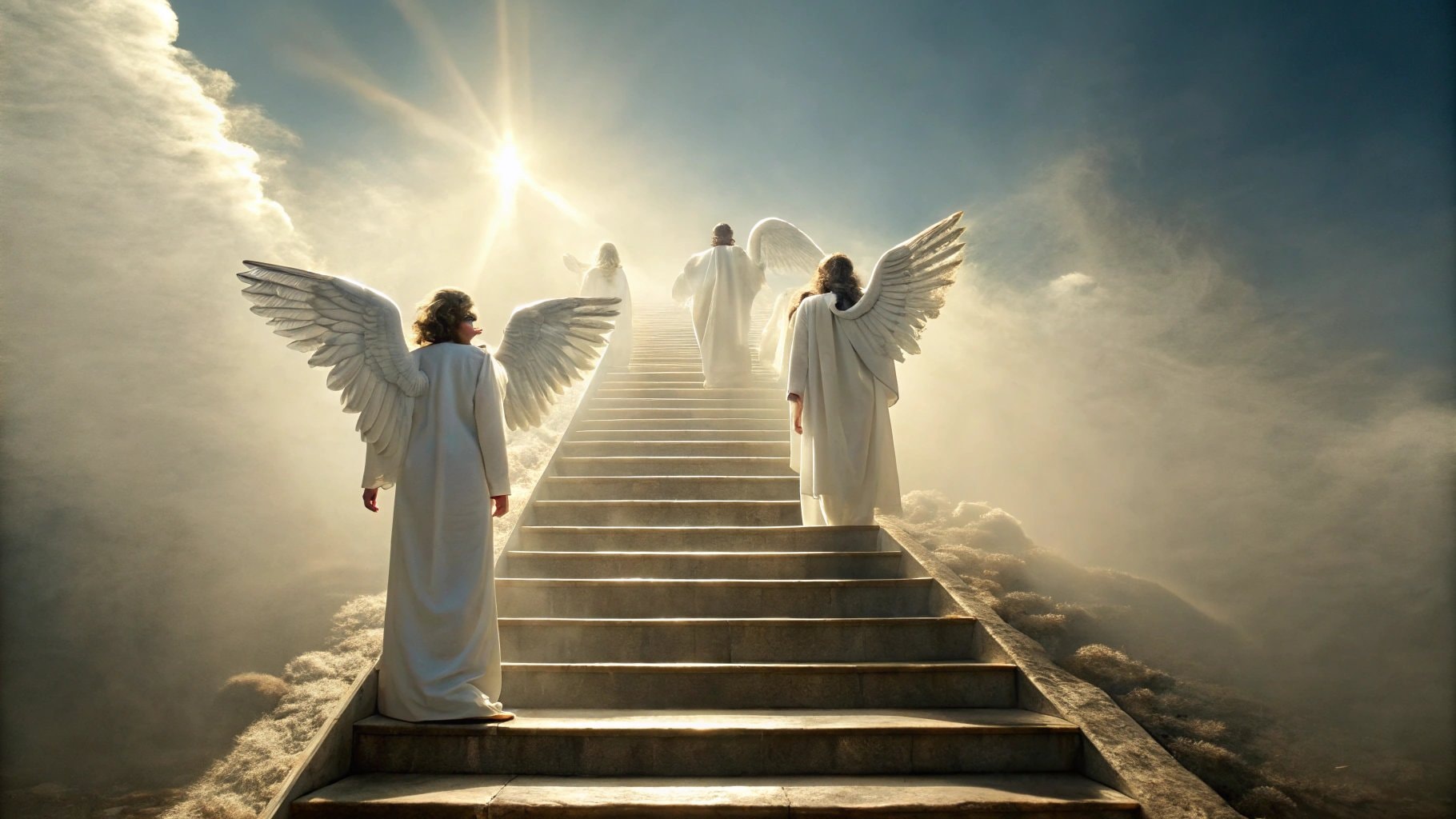What Do Angels Look Like? Understanding Their Appearance
Olivia Marie Rose | February 24, 2025

- Key Takeaways
- Angels in Popular Culture vs. Biblical Descriptions
- Biblical Descriptions of Angels: What Do They Look Like?
- What Do Angels Look Like in Heaven?
- Are Angels Scary? Why Do People Fear Them?
- Common Misconceptions About Angelic Appearances
- How to Know If You’ve Encountered an Angel
- The Role of Angels in the Bible
- Conclusion
When you hear the word angel, what picture comes to mind? A glowing figure with white robes, soft wings, and a golden halo? That’s the image most people recognize, but it’s far from what the Bible actually describes. The concept of biblically accurate angels reveals a much more complex and varied depiction.
In scripture, angels appear in many forms—some look like ordinary people, while others have multiple faces, wings covered in eyes, or bodies that shine like fire. They aren’t just peaceful messengers; they are warriors, guardians, and powerful beings sent by God. Their presence often leaves people in shock, fear, or awe.
So what do angels really look like? Are they beautiful, overwhelming, or something beyond human understanding? Let’s take a closer look at what the Bible says about their appearance—and why they are nothing like what you’ve seen in paintings or movies.

Key Takeaways
Biblical vs. Cultural Angels: The Bible depicts angels as powerful and awe-inspiring, unlike the gentle figures seen in popular culture.
Divine Roles: Angels act as God’s messengers, warriors, and protectors, fulfilling His will.
Fearsome Encounters: Biblical angelic encounters often evoke awe and fear due to their divine presence.
Angelic Hierarchy: Angels have a structured hierarchy, with archangels like Michael and Gabriel playing key roles in God’s plan.
Angels in Popular Culture vs. Biblical Descriptions
Why Do Modern Depictions Differ from the Bible?
When you picture an angel, you likely see a graceful, winged figure, dressed in flowing white robes, radiating light and peace. This image is everywhere—paintings, movies, Christmas cards. But the truth is, this version of angels is more of a cultural invention than a biblical reality.
Ancient artists and religious traditions shaped this soft, comforting portrayal of angels, emphasizing their role as protectors and messengers. However, in biblical accounts, heavenly messengers appeared to shepherds in the fields near Bethlehem to announce the birth of Jesus, distinguished by their radiant presence and divine messages. Over time, Western art and literature turned them into human-like figures with haloed heads and feathered wings, reinforcing the idea that angels are gentle, guardian-like beings.
The Biblical Reality: Angels Are Not What You Think
The Bible tells a very different story. While some angels do appear in human form, many are described as mighty, fearsome, and completely beyond human understanding. Here’s how scripture describes them:
Some have six wings—two covering their faces, two covering their feet, and two for flying (Isaiah 6:2).
Others have four faces—a man, a lion, an ox, and an eagle (Ezekiel 10:14).
Some are covered in eyes, even on their wings (Revelation 4:6-8).
Many appear as blazing fire, shining with a brightness that leaves witnesses terrified (Daniel 10:6).
Angels are warriors, capable of destroying entire armies (2 Kings 19:35).
Unlike their peaceful artistic depictions, angels in the Bible often leave people shaken, fearful, or falling to their knees in awe. For instance, the Cherubim in the Garden of Eden are depicted with a flaming sword flashing to guard the tree of life, emphasizing their role as both protectors and fearsome beings. This is why their first words to humans are often “Do not be afraid” (Luke 2:10, Matthew 28:5).
Why Does This Matter?
Understanding the true biblical descriptions of angels helps separate fiction from reality. It also gives us a deeper appreciation of their power, purpose, and divine mission. Angels are not just heavenly companions; they are God’s messengers, warriors, and worshippers, carrying out His will in ways beyond human comprehension.
So the next time you see an angel painted with soft features and golden wings, remember—the real thing is far more incredible than any artist could ever capture.
Biblical Descriptions of Angels: What Do They Look Like?

The Bible gives detailed descriptions of angels, showing that they are not just gentle, winged beings but powerful, awe-inspiring figures. As spirit beings created to serve God, some appear as warriors, some as creatures beyond human understanding, and others as ordinary people. Their appearance depends on their purpose, whether they are messengers, protectors, or worshippers in God’s presence.
1. Seraphim – The Fiery Six-Winged Angels
Seraphim are among the most mysterious angels, known for their intense, burning presence. Their name means “burning ones,” symbolizing their radiant and fiery nature. They stand closest to God’s throne, continuously worshiping Him and manifesting God’s glory.
In Isaiah’s vision, Seraphim had six wings—two covering their faces, two covering their feet, and two for flying. Their presence was so overwhelming that Isaiah felt unworthy, showing their role in representing God’s absolute holiness. They cry out, “Holy, holy, holy is the Lord Almighty”, emphasizing God’s supreme authority.
2. Cherubim – Powerful, Multi-Faced Guardian Angels
Unlike the chubby, child-like figures seen in art, Cherubim are mighty guardians of God’s holiness. The Bible first introduces them as protectors of the Garden of Eden, standing with a flaming sword after human beings, Adam and Eve, were cast out.
Ezekiel describes Cherubim as having four faces—human, lion, ox, and eagle—symbolizing different aspects of creation. Their bodies and wings are covered in eyes, representing divine knowledge and vigilance. They move in perfect unity, carrying God’s presence wherever He directs them.
3. The Four Living Creatures – Heavenly Beings Beyond Imagination
In the Book of Revelation, John describes four angelic beings that surround God’s throne. They resemble a lion, ox, man, and eagle and are covered in eyes, symbolizing their divine awareness. Each has six wings and continuously worships God, declaring His holiness day and night.
Their purpose is to glorify God, demonstrating His power and authority over all creation. Their appearance is unlike anything on Earth, reminding us that heaven operates beyond human understanding.
4. Archangels – Warriors and Messengers
Archangels are high-ranking angels with key roles in God’s plan. The Bible names two: Michael and Gabriel.
Michael is a warrior angel, leading God’s armies against evil. He is described as a protector of God’s people, battling against demonic forces. In Revelation, he fights against Satan, securing victory for heaven.
Gabriel, on the other hand, is a messenger angel, delivering divine announcements. He appears to Daniel, Zechariah, and Mary, revealing God’s plans. Unlike Michael, who leads battles, Gabriel communicates God’s will to humans in a way they can understand, including the announcement of the birth of Jesus Christ.
5. Ordinary-Looking Angels: When Angels Appear as Humans
Not all angels have a striking, supernatural appearance. Some look just like people, blending into daily life. The Bible warns that some have entertained angels without realizing it.
Abraham’s three visitors appeared as men, yet they brought messages from God and foretold the destruction of Sodom and Gomorrah. Similarly, angels at Jesus’ tomb looked like young men, speaking to the women who came to find Him. These accounts suggest that angels can take human form when necessary, but it is important to understand that they are not physical beings. They are fundamentally distinct from physical entities, carrying out their divine missions unnoticed.
What Do These Descriptions Teach Us?
Angels are not the soft, delicate figures often seen in paintings. They are powerful, fearsome, and otherworldly spiritual beings, each created for a specific purpose. Some are warriors, others worshippers, and some messengers, but all exist to carry out God’s will.
The biblical descriptions of angels reveal a reality far greater than human imagination—one where God’s presence is guarded, His messages are delivered, and His power is carried out by celestial beings beyond our understanding.
What Do Angels Look Like in Heaven?

Angels in heaven are not like the soft, glowing figures seen in paintings. The Bible describes them as radiant, awe-inspiring, and sometimes terrifying beings, reflecting God’s majesty and power. Their appearance varies depending on their role—some are warriors, others are worshippers, and some are messengers, while other angels, such as cherubim and archangels, have distinct roles and ranks within the angelic hierarchy.
Angels Are Glorious and Radiant
When angels appear in heaven, they are often described as shining with divine light. In Matthew 28:3, the angel at Jesus’ tomb had an appearance “like lightning” and clothes “as white as snow.” In Daniel 10:6, an angel’s face shone like lightning, his eyes were like flaming torches, and his voice sounded like a multitude of people speaking at once.
Their overwhelming brilliance reflects the glory of God, making it difficult for humans to gaze upon them without fear or awe.
Angels Are Otherworldly Beings
Some heavenly angels look completely unlike anything found on Earth. In Revelation, John describes four living creatures around God’s throne with six wings and bodies covered in eyes. These beings continuously worship God, declaring “Holy, holy, holy is the Lord God Almighty” (Revelation 4:6-8).
Similarly, Ezekiel’s vision of angelic beings includes Cherubim with multiple faces—a human, a lion, an ox, and an eagle—and wheels that move with them, covered in eyes (Ezekiel 1:4-21). These descriptions suggest angels are far beyond human imagination, created for divine purposes rather than earthly resemblance.
Angels Are Worshippers in God’s Presence
One of the most common images of angels in heaven is their role as worshippers surrounding God’s throne. The Seraphim, mentioned in Isaiah 6:2-3, have six wings and constantly proclaim God’s holiness. Their presence signifies God’s supreme authority and the unending worship in heaven.
Angels are not the focus of heaven—God is. Their appearance, voices, and actions all point toward His greatness, power, and glory.
Why Do Angels Look Different in Heaven?
The way angels appear in heaven often reflects their purpose. Some are messengers and take on human form when interacting with people, while others—like the Cherubim and Seraphim—are designed to serve in God’s presence, displaying their heavenly nature in ways that go beyond human understanding.
Every biblical vision of heaven describes angels as powerful, radiant, and overwhelming, reminding us that the heavenly realm is far more majestic and mysterious than anything we can imagine.
Are Angels Scary? Why Do People Fear Them?
When most people think of angels, they imagine gentle, glowing figures with soft wings and kind faces, often as guardian angels. But in the Bible, angelic encounters often leave people trembling, falling to the ground, or overwhelmed with fear. Angels are not cute, comforting beings—they are powerful, supernatural entities that serve as warriors, messengers, and enforcers of God’s will.
Why Are Angels So Fearsome?
1. They Radiate Divine Power
Angels are not ordinary beings; they come from God’s presence, carrying His glory and authority. When an angel appeared at Jesus’ tomb, his appearance was “like lightning”, and his clothing was “as white as snow” (Matthew 28:3). The guards were so terrified that they shook and became like dead men. These ministering spirits are sent by God to serve those who will inherit salvation.
2. They Are Often Warriors
Many angels are described as mighty warriors, equipped for battle. In 2 Kings 19:35, a single angel struck down 185,000 enemy soldiers in one night. In Revelation, Michael the archangel leads the heavenly armies against Satan. These are not delicate, peaceful figures but formidable beings who carry out God’s judgment and protection.
3. They Appear in Otherworldly Forms
Some angels look nothing like humans. The Cherubim have four faces (human, lion, ox, and eagle), multiple wings, and bodies covered in eyes (Ezekiel 10:14). The Seraphim have six wings, with two covering their faces, two covering their feet, and two for flying (Isaiah 6:2). These descriptions are unlike anything seen on Earth, making them both fascinating and terrifying.
4. Their Presence Overwhelms Humans
Almost every time an angel appears in the Bible, the first thing they say is “Do not be afraid” (Luke 2:10, Matthew 28:5). This suggests their appearance is so intense that humans instinctively react with fear. When Daniel saw an angel, he became pale and weak (Daniel 10:7-8). Even the apostle John, who had seen the resurrected Jesus, fell at the feet of an angel in fear (Revelation 22:8).
Fear, Awe, and the Role of Angels
Angels are not meant to bring comfort in the way we often imagine. Their presence is a reminder of God’s power, holiness, and authority. They act as divine messengers, warriors, and enforcers of God’s will, which is why their arrival often leaves people overwhelmed with awe and fear.
So yes—angels can be scary, but not because they are evil or harmful. Their appearance, strength, and divine radiance make them overwhelming to the human mind. They are not meant to be feared like demons, but they command deep respect because they serve the Almighty God.
Common Misconceptions About Angelic Appearances
Many beliefs about angels come from art, movies, and folklore rather than the Bible. Here are some of the most common misunderstandings.
1. Angels Are NOT Dead Humans
One of the biggest misconceptions is that people become angels when they die. The Bible makes it clear that angels and humans are completely separate creations. Angels were created before humans and do not experience birth or death like we do (Job 38:4-7, Luke 20:36). While humans have the possibility of redemption, fallen angels do not (Hebrews 2:16). When a person dies, they remain human souls in the afterlife—they do not transform into angels.
2. Not All Angels Have Wings
While some angels, like Seraphim and Cherubim, are described with wings, others appear in human form. The angels who visited Abraham and Lot looked like ordinary travelers (Genesis 18-19). The angel who appeared to Mary spoke with her as if he were a man (Luke 1:26-28). The Bible even warns that people may encounter angels unknowingly because they look human (Hebrews 13:2). The common image of winged angels is mostly an artistic tradition rather than a biblical one.
3. Fallen Angels (Demons) Are NOT the Same as Biblical Angels
Some assume that demons are just angels who made a mistake. However, fallen angels are fundamentally different from the holy angels who serve God. Holy angels obey God, worship Him, and carry out His commands, while fallen angels rebelled and were cast out (Revelation 12:7-9). Unlike holy angels, who bring messages of truth, fallen angels work against God’s will and deceive people (2 Corinthians 11:14).
How to Know If You’ve Encountered an Angel
Angelic encounters are rare, but the Bible suggests they do happen. Signs of an angelic presence may include:
1. A Divine Message or Guidance
Angels in the Bible often deliver important messages. They appeared to Mary to announce Jesus’ birth (Luke 1:26-38), to Joseph in a dream (Matthew 1:20), and to the shepherds in the field (Luke 2:9-14). If you experience a moment of clear, divine guidance that aligns with God’s will, it could be an angelic encounter.
2. A Mysterious Stranger Helping in Crisis
Many biblical accounts describe angels appearing as ordinary people, offering help and then disappearing. In Genesis 18, Abraham welcomed three visitors, later realizing they were divine messengers. Many believers today share stories of strangers offering help in life-threatening situations, only to vanish without a trace.
3. A Dream or Vision with Overwhelming Peace
Throughout scripture, angels appear in dreams and visions to guide people. Joseph received angelic messages in his dreams, warning him to flee to Egypt (Matthew 2:13). Angels also appeared in visions to Daniel, Ezekiel, and John, delivering prophecies and revelations. If you experience a dream that carries divine truth and an overwhelming sense of peace, it may be an angelic encounter.
While angels are mysterious, the Bible clarifies that their purpose is always to serve God, carry out His will, and guide people toward truth.
The Role of Angels in the Bible
Angels play an important role in the Bible. They are messengers, protectors, warriors, and worshipers, always carrying out God’s plans. They don’t act on their own but follow His commands.
Angels often appear when something big is about to happen—they bring messages, warn people of danger, offer guidance, and even fight battles. They were present at Jesus’ birth, His time in the wilderness, and His resurrection, showing how closely they are tied to God’s work.
Angels as Messengers
One of the main jobs of angels is to deliver messages from God. As ‘angels ministering spirits’, they serve those who will inherit salvation, acting as messengers, protectors, and executors of God’s will. The Bible is full of stories where they appear to people, bringing important news.
Gabriel, one of the most well-known angels, appeared to Mary to tell her she would give birth to Jesus (Luke 1:26-38). Angels also spoke to Joseph in a dream, warning him to escape to Egypt with Mary and baby Jesus (Matthew 2:13). After Jesus’ resurrection, angels were at the tomb, telling the women that He had risen (Matthew 28:5-7).
Angels don’t just bring messages—they also carry out God’s justice and protection. In Genesis 19, they warned Lot to leave Sodom before it was destroyed. In Exodus 23:20, God sent an angel to lead the Israelites safely.
Angels in the Life of Jesus
Angels were closely involved in Jesus’ life. They announced His birth to Mary and the shepherds, showing His importance from the very beginning (Luke 1:26-33, Luke 2:8-14).
They also took care of Him after He fasted for forty days in the wilderness (Matthew 4:11) and gave Him strength in the Garden of Gethsemane before His arrest (Luke 22:43). After His death, angels rolled away the stone at His tomb and told His followers He had risen (Matthew 28:2-7).
Even though angels are powerful, Jesus is greater than all of them. The Bible says angels worship Him, recognizing He is God’s Son (Hebrews 1:6).
Conclusion
Angels are more than the gentle figures seen in paintings. The Bible describes them as powerful, awe-inspiring, and sometimes terrifying. Some shine with heavenly light, others stand as warriors, but all exist for one purpose—to carry out God’s will.
Their true form remains a mystery, but their presence is never ordinary. When angels appear, they bring messages, protection, and moments that change lives forever. Whether seen or unseen, they remind us that God is always at work, moving in ways beyond human understanding.
Recent Posts

Explore Astrology and Numerology with a Free Online Fortune Teller
Olivia Marie Rose | April 5, 2025

April 10 Zodiac Sign: Embracing the Fiery Spirit of Aries
Aryan K | April 5, 2025

2025 Comprehensive Guide to the Queen of Cups Tarot Card
Aryan K | April 4, 2025

Virgo and Capricorn Compatibility: Understanding Love, Sex, and Friendship
Aryan K | April 4, 2025

November 30 Zodiac: What Being a Sagittarius Means for You
Aryan K | April 4, 2025
Topics
- 4 Digit Angel Numbers
- 5 Digit Angel Numbers
- 6 Digit Angel Numbers
- Astrology and Birth Charts
- Business Astrology
- Career Astrology
- Celebrities and Personalities Astrological Profile
- Children Astrology
- Chinese Astrology
- Different Angel Numbers Meaning
- Double Digit Angel Numbers
- Dreams Interpretation
- Festivals
- Finance Astrology
- Find Baby Names
- Find Best Astrologers
- Gemstones and Birthstones
- Janam Kundli Chart
- Love Astrology
- Marriage Prediction Astrology
- Nakshatra (Constellations)
- Numerology
- Pet Astrology
- Rudraksha Beads
- Single Digit Angel Numbers
- Spirit Animals
- Spirituality and Positivity
- Stars, Planets and Cosmic
- Symbolism
- Tarot Cards
- Triple Digit Angel Numbers
- Understanding Hinduism
- Vastu Shastra
- Vedic Astrology
- Western Astrology
- Yoga and Meditation
- Zodiac Sign Date Calendar
- Zodiac Signs
- Zodiac Signs Compatibility
